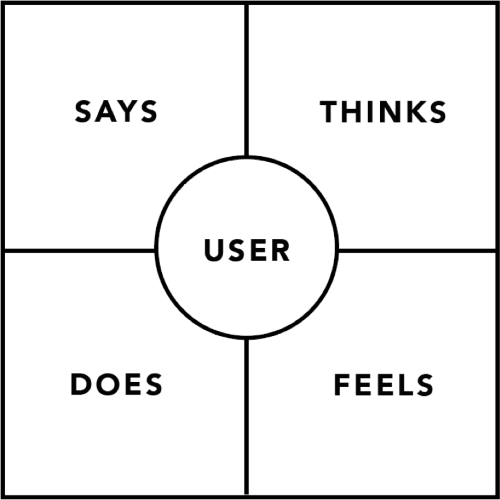Unit 1: Determine Needs or Wants
Contents
Unit 1: Determine Needs or Wants#
Determining the human needs and wants provides us with an understanding that we can use to assess the effectiveness of solution, as well as the individual constituent components.
Empathy Maps#
To help identify user needs, UX professionals use empathy maps.
To fill out an empathy map, consider:
Says - what the user says about the problem in an interview or some other usability study.
Thinks - what the user is thinking throughout the experience.
What occupies the user’s thoughts?
What matters to the user?
It is possible to have the same content in both Says and Thinks. However, pay special attention to what users think, but may not be willing to vocalize.
Does - the actions the user takes.
What does the user physically do?
How does the user go about doing it?
Feels - the user’s emotional state, often represented as an adjective plus a short sentence for context.
What worries the user?
What does the user get excited about?
How does the user feel about the experience?
Synthesise the user’s needs based on the empathy map. This will help define the design challenge. To synthesise an empathy map, group similar recorded observations together in order to find themes. Then Identify needs directly from the user traits noted.
In doing this be aware that:
Needs are verbs and frame activities, actions and desires.
Refrain from using nouns as they will lead to defining solutions, and this is not the aim of the process.
Personas#
To ensure that the digital solution is meeting the needs of the user, rather than the needs of the developer, UX professionals employ user personas.
Personas are fictional representations and generalisations of user clusters which identify:
attitudes
goals
behaviours
You should have one or two personas which are the aggregation the most important considerations derived from interviewing target users. If you do not have access to target users, then the personas can be developed using assumptions, competitor analysis and internal stakeholder interviews.
When interviewing personas you need to consider:
personal life
technical background
employment
professional questions
Personas need to be specific, rather than general, so create a fictitious person.
Components of a persona:
image (of a real person)
name
profile (summary)
goals (general goal in life)
demographics
age
education
gender
ethnicity
family status
occupation
motivations
expectations
frustrations with the problem
environment
physical
social
technological
personality (Big Five Personality Traits)
openness
contentiousness
extraversion
agreeableness
neuroticism


